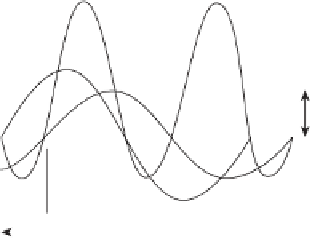Environmental Engineering Reference
In-Depth Information
v
i
p
p
V
AB
P
i
AB
t
t
q
T
Figure A.17
Power in a mixed circuit
as a consumer and during other parts as a generator of power. What decides whether the
element is a consumer or generator of power over the long run is the sign of the integral:
1
tT
+
∫
P
=
pt
d
(A.24)
T
t
=
sin
sin
(
)
Let
vV t
AB
ω
and
i
=
I
ωθ
t
−
. Then
AB
AB AB
(
)
pvi
=
=
V
sin
ωωϑ
tI
sin
t
−
Using a trigonometric identity,
1
2
1
2
(
)
φ ω θ
Using Equation (A.2) to convert the peak into RMS quantities gives
pVI
=
cos
−
VI
cos
2
t
−
(
)
2
Introducing this expression into the integral of Equation (A.24) and integrating between the
limits gives
pVI
=
cos
φ
−
VI
cos
ω
t
−
θ
θ
(A.25)
PVI
=
cos
as the second term represents a symmetrical sinusoid, the average value of which over a
period
T
is zero.
Equation (A.25) is of great signifi cance in power systems engineering. The product
VI
is
known as
apparent
power and is measured in
volt - amperes
. The term cos
θ
is known as the
power factor
and
as the
power factor angle
. It is the product of the power factor with the
apparent power that results in the
active power P
which is measured in
watts
. The power
factor is unity when the voltage and current are in phase, i.e. for a purely resistive element
(Equation (A.7)). These are the only circumstances when the volt-amperes are equal to the
watts.
The apparent power, being the product of two RMS scalar quantities that are always posi-
tive, is also always positive. It follows that the sign of Equation (A.25), i.e. whether the
element is a consumer or a generator of power, depends solely on the sign of cos
θ
θ
. It should







